There’s no need to pack your SUP away in winter. While the summer months make paddling easier in many ways, it would be a shame to put your favourite hobby on hold for an entire season.
If you’re armed with the right knowledge, you can get just as much pleasure from paddle boarding in winter. Plus, you’ll get the added satisfaction that you’re out there having fun when others are missing out.
Here you’ll find everything you need to make winter paddle boarding a safe and enjoyable experience.
1. Know what to wear when paddle boarding in winter
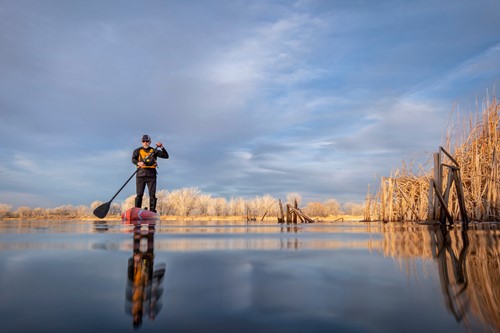
‘Neoprene’ is the buzzword regarding what to wear when paddle boarding in winter.
It’s entirely waterproof and incredibly insulating, which makes it the best material for protecting yourself in wet and cold conditions.
Here’s a quick guide to layering up efficiently, so you’re prepared for colder water temperatures if you fall in.
Body
While drysuits are entirely waterproof and keep any layers underneath them dry, they can feel bulky and restrict your movement during winter paddle boarding. They’re usually better suited for kayaking, where you are less likely to fall into the water.
A quality neoprene wetsuit is the most popular choice amongst paddle boarders.
They’ll keep you insulated enough to deal with colder water temperatures but will provide greater freedom of movement, making the activity easier overall.
It’s also best to wear a base layer beneath your wetsuit. Here are some options you may want to look at:
Head
When the rest of you is clothed, your head can feel particularly exposed in colder temperatures.
There are a range of neoprene hats, beanies and surf hoods out there that are particularly good for keeping your head insulated when winter paddle boarding, especially if you think you’re at risk of getting wet.
Hands
Your regular woolly gloves might do the trick if you’re an experienced paddle boarder. But, if you fall into the water, they won’t give your hands much protection. Neoprene gloves are designed to keep your hands warm, even if they’re wet.
These gloves are specifically designed for paddle boarding in winter, as they’re double-lined and have a water-repellent coating. The palms have added grip to maintain control over your paddles.
Feet
As with gloves, woolly socks are likely to become uncomfortable if wet.
Neoprene socks are a great option for winter paddleboarding, especially if you opt for a pair with thermal lining.
A decent pair of socks will keep you insulated whilst protecting you from cold water and wind chill. Look out for socks with added grip if you’re not wearing shoes, as this will prevent you from slipping off your paddle board, especially when it inevitably becomes wet.
Wetsuit boots and neoprene shoes offer added protection for your feet and more stability when balancing on your board.
Related: The 10 best paddle board accessories
2. Get the right safety gear
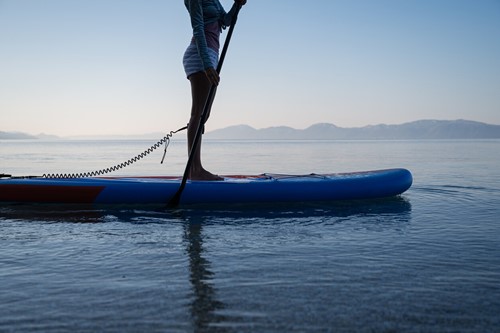
Safety should take priority when paddle boarding in winter—it’s typically lonelier and riskier when compared to doing so during the summer months. Here are some essential items to add to your checklist.
SUP leash
No matter the water you’re paddling in, you should always bring an SUP leash as a precaution.
Having your board attached to you at all times is crucial. You’ll be prepared if you get into any trouble, which can happen to even the most experienced paddle boarders.
Full water bottle
It’s easy to forget to keep hydrated in cold conditions if you compare this to how thirsty you become when paddling in the heat of summer. But it’s dangerous to overlook hydration, especially if you’re out for hours.
Ensure you always keep a full water bottle within reach to keep your fluid intake up. You might even want to bring a flask of hot water or tea to keep you warm.
Life jacket
A life jacket, otherwise known as a PFD (personal floatation device), is an essential piece of equipment for paddle boarding in winter.
Swimming in cold water is especially difficult, as the lower temperature can shock your body and cause you to freeze up. A PFD will keep you afloat and allow you to safely get back onto your board.
Extra layers of clothing
Since the weather is so unpredictable during the colder months, it’s a good idea to bring extra layers of clothing to prepare you for any temperature drops or unexpected conditions.
Plus, even experienced paddle boarders can fall into the water, affecting how quickly you feel the cold.
A dry bag is a good idea, as you can store extra layers such as a body warmer or waterproof jacket on your back and keep them dry as you paddle.
LED light
This is a great way of making yourself visible to other paddle boarders or boaters. It gives you peace of mind that you won’t struggle to see or be seen in poor conditions.
A head torch or specially made SUP light are some of the most popular options.
Fully charged mobile phone
Always take your mobile phone in a waterproof case or a dry bag so you can contact help in an emergency. Make sure it’s fully charged up before you set out.
3. Find a suitable location
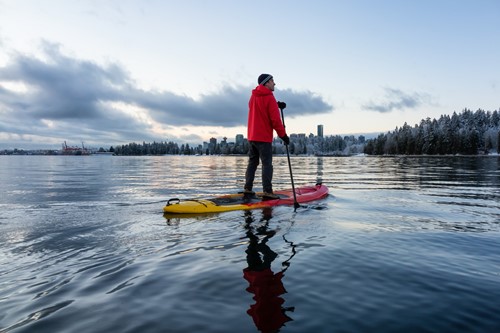
If you’re new to winter paddle boarding, it’s a good idea to stick to what you know. We wouldn’t suggest heading to locations you’re unfamiliar with.
The ideal place is somewhere with flat water where you can stay relatively close to the shore. That way, you won’t feel too out of your depth if you get into trouble.
You’ll also be less likely to fall in when the conditions are calm, so you might not need to layer up as much.
Related: The 7 best paddle boarding locations in the UK
4. Check the weather beforehand
Planning and preparation are key when paddle boarding in winter.
Checking the weather before you head out is a huge part of this, as knowing what to expect will help you choose the right location, layer up accordingly, and pack the right safety gear.
For example, if conditions are particularly dark or gloomy, you may want to take an LED light to improve visibility and to ensure other people can see you.
5. Tell a friend you’re going
Ideally, you’ll have a winter paddle boarding partner. This makes the whole experience safer, as you’re less likely to lose your bearings or get into difficulty when you’re with someone else.
However, if you’re heading out alone, let someone know where you are and when you will likely return home. That way, you’ll know help is on the way in the worst-case scenario.
6. Avoid ice
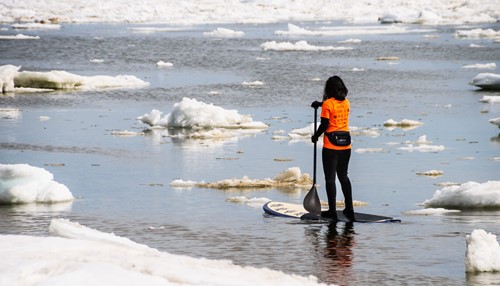
Ice is one of the main hazards to look out for when paddle boarding in winter, especially if you’re on an inflatable paddle board. Since it’s solid and sharp, it can easily do damage.
Avoid it when you’re paddling, and don’t be tempted to step on it to get to the water—doing so is incredibly dangerous.
If you’re out in dark conditions, pay extra attention to where you’re paddling and look for any chunks of ice floating around. It isn’t always intact—smaller sections can break away and float to other areas as it melts.
7. Stay close to the shore
We touched on this point earlier but can’t stress its importance enough.
Even if you’re an experienced paddle boarder, the winter months bring unpredictable conditions that can be dangerous to navigate if you’re taken by surprise.
Staying within 15 feet of the shoreline is the best way to keep your experiences safe and enjoyable. You won’t have the added worry of getting caught out by poor weather, ice, or wind chill.
Plus, if the temperature isn’t too low, you won’t have to wear every layer in your wardrobe if you’re paddling on calm waters and not too far from the shore.
Related: 7 paddle boarding mistakes that are easy to avoid
8. Prepare for the dark
Just like you should check the weather forecast ahead of winter paddle boarding, you should also be prepared for when the nights start drawing in.
Check the approximate sunset time before setting out and keep track of time whilst you’re paddling so you don’t get caught out after dark.
As we mentioned earlier, it’s also a good idea to take a light source with you for added visibility, as this becomes increasingly important in low-light conditions.
9. Keep yourself warm and refuelled
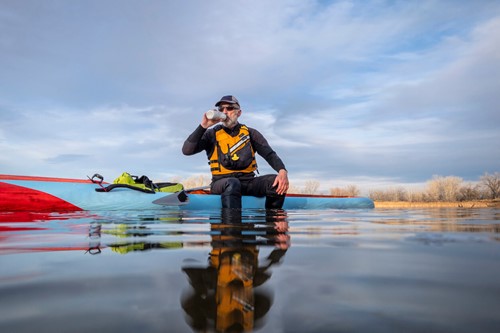
We know the score. You’ve been out paddle boarding for a couple of hours and got yourself wet and cold, only to return to your car with nothing to warm you up—it happens to the best of us.
Having a blanket and a spare change of clothes ready and waiting for you in your car is a useful step to add to your preparation list. It can make the recovery process much more comfortable for you.
You may also want to bring a hot drink in a vacuum flask and some snacks so you can properly refuel after a heavy winter paddle boarding session.
Specialist paddle board insurance through Insure4Boats
No matter the season, you might want to protect your SUP through specialist paddle board insurance for extra peace of mind.
At Insure4Boats, the cover is designed to protect your SUP against theft, loss, and damage.
You’ll also receive £3m of Public Liability cover as standard, so you’ll be protected against claims if you injure someone or damage third-party property whilst out paddle boarding.
Personal Accident cover is available as an optional extra to protect you if you’re injured in a paddle boarding accident.
Find out more about how we can help here, or get an online quote in minutes.
Please note the information provided on this page should not be taken as advice and has been written as a matter of opinion. For more on insurance cover and policy wording, see our homepage.

